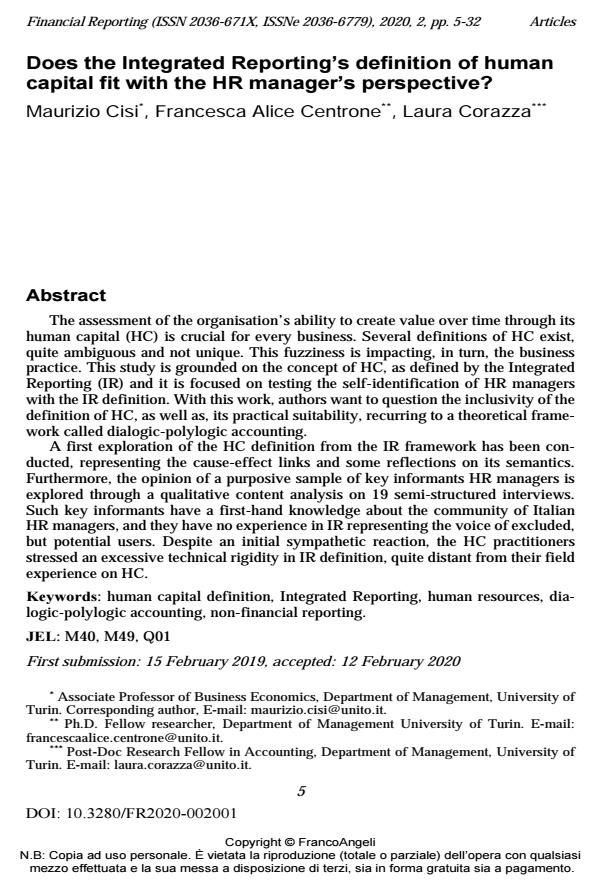Does the Integrated Reporting’s definition of human capital fit with the HR manager’s perspective?
Titolo Rivista FINANCIAL REPORTING
Autori/Curatori Maurizio Cisi, Francesca Alice Centrone, Laura Corazza
Anno di pubblicazione 2020 Fascicolo 2020/2
Lingua Inglese Numero pagine 28 P. 5-32 Dimensione file 178 KB
DOI 10.3280/FR2020-002001
Il DOI è il codice a barre della proprietà intellettuale: per saperne di più
clicca qui
Qui sotto puoi vedere in anteprima la prima pagina di questo articolo.
Se questo articolo ti interessa, lo puoi acquistare (e scaricare in formato pdf) seguendo le facili indicazioni per acquistare il download credit. Acquista Download Credits per scaricare questo Articolo in formato PDF

FrancoAngeli è membro della Publishers International Linking Association, Inc (PILA)associazione indipendente e non profit per facilitare (attraverso i servizi tecnologici implementati da CrossRef.org) l’accesso degli studiosi ai contenuti digitali nelle pubblicazioni professionali e scientifiche
The assessment of the organisation’s ability to create value over time through its human capital (HC) is crucial for every business. Several definitions of HC ex-ist, quite ambiguous and not unique. This fuzziness is impacting, in turn, the busi-ness practice. This study is grounded on the concept of HC, as defined by the Inte-grated Reporting (IR) and it is focused on testing the self-identification of HR managers with the IR definition. With this work, authors want to question the in-clusivity of the definition of HC, as well as, its practical suitability, recurring to a theoretical framework called dialogic-polylogic accounting. A first exploration of the HC definition from the IR framework has been con-ducted, representing the cause-effect links and some reflections on its semantics. Furthermore, the opinion of a purposive sample of key informants HR managers is explored through a qualitative content analysis on 19 semi-structured interviews. Such key informants have a first-hand knowledge about the community of Italian HR managers, and they have no experience in IR representing the voice of ex-cluded, but potential users. Despite an initial sympathetic reaction, the HC practi-tioners stressed an excessive technical rigidity in IR definition, quite distant from their field experience on HC.
Parole chiave:Human capital definition, Integrated Reporting, human resources, dia-logic-polylogic accounting, non-financial reporting.
Jel codes:M40, M49, Q01
- The Human Capital for Value Creation and Social Impact: The Interpretation of the IR’s HC Definition Maurizio Cisi, Francesca Alice Centrone, in Sustainability /2021 pp.6989
DOI: 10.3390/su13136989 - Does the Adoption of Planning and Control Tools Influence Performance? Opinions of Grantors and Grantees About Non-profit Projects Giacomo Boesso, Fabrizio Cerbioni, Andrea Menini, in FINANCIAL REPORTING 2/2022 pp.35
DOI: 10.3280/FR2022-002002
Maurizio Cisi, Francesca Alice Centrone, Laura Corazza, Does the Integrated Reporting’s definition of human capital fit with the HR manager’s perspective? in "FINANCIAL REPORTING" 2/2020, pp 5-32, DOI: 10.3280/FR2020-002001